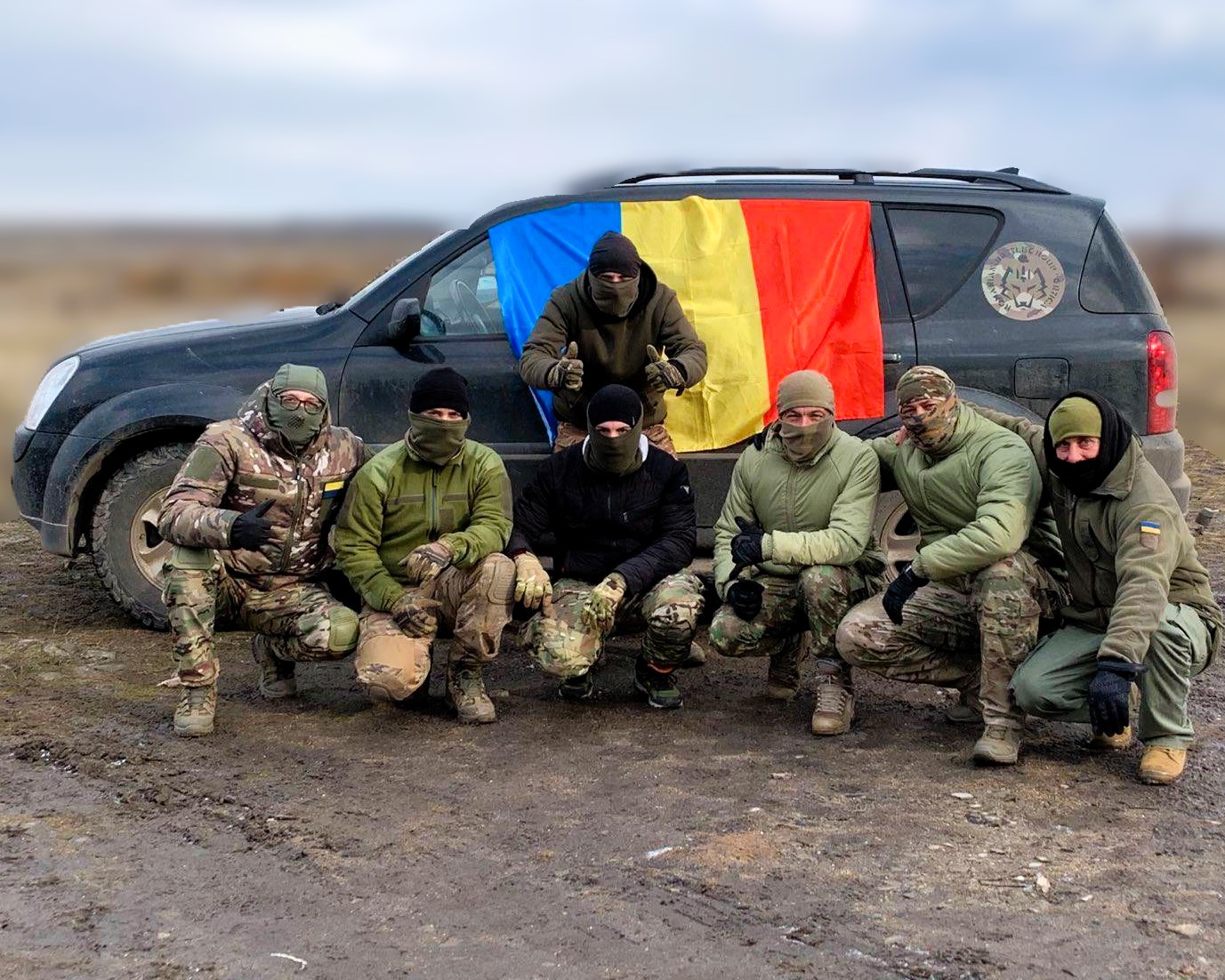- PressHub, through a press campaign based on official data and reports from the Ukrainian front, has fact-checked claims about the mobilization of Romanian soldiers to fight in Ukraine or their alleged presence already in this war.
The investigation sought to establish the truth behind the narratives promoted by extremist and sovereigntist parties, which intensified after May.
The lack of official data collected and published by Romanian state authorities has favored manipulation of the public. - At the time of PressHub’s documentation, neither the Ministry of Foreign Affairs (MAE) nor the Ministry of National Defense (MApN) could clearly and officially specify the number of Romanians residing in Romania who have fought on Ukraine’s side since February 24, 2022, the date of Russia’s invasion.
- However, PressHub obtained documents, statements from officials, and testimonies from Romanians present on the battlefield as representatives of civil society. These indicate that the number of Romanians who went to fight in Ukraine did not exceed 100 people between February 2022 and August 2025.
- These are Romanians, mostly with prior military experience outside the Romanian Army, who chose—primarily out of conviction—to defend Ukraine and thus keep the Russian invasion away from Romania’s border. These Romanians are paid by the Ukrainian army with the same wages as Ukrainian recruits.
- Unfortunately, there were also two cases of Romanians—a man from Arad and another from Argeș—who enlisted in the Ukrainian army and died in clashes with Russian soldiers.
“Anghel,” a Romanian from the Moldavia region, fought for one year on the Ukrainian front. He left of his own accord, convinced that Russia’s invasion must be stopped as far as possible from Romania’s borders. He had military experience, but had not served in the Romanian Army.
In his first months as a “Ukrainian” soldier, he was sent to hot zones, facing Russian artillery fire almost daily. He quickly learned procedures, and his Ukrainian comrades regarded him as one of the most disciplined foreign volunteers.
It should be noted that the term “volunteer” on the Ukrainian front refers to foreigners who support Ukraine’s cause without being compelled by recruitment obligations. Such volunteers join the Ukrainian army by choice.

A Ukrainian soldier earns a base salary of about 20,100 UAH per month (approx. USD 484), according to official military pay rates. For foreign volunteers directly involved on the front lines, payments can rise to 220,000 UAH (approx. USD 5,000), as was the case for Anghel. In case of death, the soldier’s family receives a one-time aid of up to 15 million UAH (about USD 400,000).
News About Mobilization in Romania Made Him Return
Anghel says it was not money that motivated him, but the desire to right the injustice of a powerful state invading a smaller neighbor.
He returned to Romania after one year, due to health issues caused by minor wounds sustained on the front and because his family needed him.
“My family kept calling me back every week. Earlier this year I gave in, luckily my contract was expiring too. They told me things were getting bad at home. That if I wanted to fight, I should enlist in Romania, since we would also send troops. Others warned me that if a certain candidate won the May elections, I risked being labeled a traitor,” recalls the young man.

“Honestly, it’s a strange, really strange feeling—to be under Russian fire, fighting for a cause, and at the same time thinking you might not be able to return home if a certain candidate wins—I won’t say who. Maybe he’d consider me a traitor for fighting for Ukraine. In the end, I came back,” says the former soldier.
During his 12 months on the Ukrainian front, Anghel says he heard of or met almost 20 other Romanians—volunteers residing in Romania who were fighting in the Ukrainian army.
The Campaign
After the May 18 presidential elections, in which extremist and sovereigntist candidates such as George Simion and Călin Georgescu lost to pro-European options, online and offline manipulation networks quickly shifted strategy.
Before the vote, the focus had been on attacking European values and spreading conspiracy theories favorable to radical candidates. After the elections, the narrative moved to a new sensitive issue: fear of war.
False stories began to circulate widely, claiming that Romanian authorities were preparing to draft young people to send them to the Ukrainian front, or that Romanian soldiers were already fighting there.
Three examples:
- Post on X (formerly Twitter) about reservist mobilization
On May 21, 2025, a post appeared on X including an internal Metrorex memo, presented as “evidence” that authorities were preparing to mobilize reservists to be sent to Ukraine. The Ministry of National Defense (MApN) quickly flagged this as disinformation. - Article on spotmedia.ro about the MOBEX exercise
In June 2025, MApN clarified that the routine military exercise MOBEX OT-GR-TR-25, conducted in Olt, Giurgiu, and Teleorman counties between May 26–31, aimed only to assess mobilization reserves—without any connection to sending Romanian troops to Ukraine. This too was debunked as disinformation.

- Response from the Presidential Administration to TikTok disinformation
On May 23, 2025, the Presidential Administration categorically denied the false TikTok news claiming that Romania was preparing to deploy troops in Ukraine. Officials stressed no such decision had been made and that the claims were taken out of context.
The original post contained alleged recruitment orders, widely distributed by anonymous accounts, accompanied by alarmist narratives about Romania’s “forced involvement” in the Russia–Ukraine conflict.
Authorities clarified there was no military mobilization underway and that such claims sought to create panic, undermine trust in the army, and fuel pro-Russian narratives.

Romanians Frightened by Fake News Vote for Extremist Parties
This manipulation, involving claims that Romanian soldiers are fighting or being prepared to be sent to Ukraine, is used strictly for political purposes.
Almost 42% of Romanians are worried that Romania might get involved in a war, according to an INSCOP Research poll conducted May 26–30. This percentage mirrors the sovereigntist electorate, which has started believing the manipulative narratives of such parties.
“I publicly call on Ilie Bolojan not to involve Romania in sending troops or weapons to Ukraine. He has no mandate for this—we are waiting for democracy to return,” wrote George Simion on his Facebook page in March.
Simion received nearly 41% of the vote in the May 4 first round of Romania’s presidential election. In the end, in the runoff, he lost to the current president, Nicușor Dan.
Thus, the percentage of Romanians who believe the country will be drawn into the war with troops and those who vote for an extremist candidate is almost identical (42% versus 41%).
The Secrecy of the Defense Ministry Helps Fake News Propaganda
The reality, however, is completely different, according to information obtained by PressHub.
Romania has not sent soldiers to the war in Ukraine and does not intend to, officials from the Ministry of National Defense confirmed.
In all his public appearances since the new government took office, Ionuț Moșteanu, the Minister of Defense, has insisted that the Romanian Army has not sent troops to Ukraine, and Romania has “consistently, since the war began, limited its help to Ukraine to equipment and ammunition.”
“Romania has not sent combat units to Ukraine, and authorities are not considering such a decision,” another senior MApN official told us. We cannot name him, since he did not have authorization from the Romanian Army to speak on the matter. In fact, the Ministry of Defense has consistently refused to answer PressHub’s questions during the investigation.
Among our questions: whether MApN keeps records of Romanians residing in Romania who went to fight in Ukraine; whether former soldiers, reservists, or those on extended leave from service had joined the fighting on either side.
So far, we have received no answers.
Neither Does the Ministry of Foreign Affairs Have Information
The Ministry of Foreign Affairs (MAE) responded to PressHub that it “does not hold statistical information on the composition of Ukraine’s armed forces” nor “on their losses or those of Ukraine’s civilian population,” since “such data are not made public by Ukrainian authorities under martial law.”
MAE stressed that “members of Romania’s armed forces are not involved in the conflict” and that it has “no official information about any Romanian citizens serving in Ukraine’s armed forces, including regarding casualties.”
According to the institution, any such presence would be “exclusively the result of a personal decision, without the involvement of Romanian authorities.”
As for Ukrainian citizens of Romanian ethnicity, MAE clarified that they have “the same obligations as all other Ukrainian citizens” and there are “no data on discriminatory practices” in recruitment.
But How Many Romanians Have Fought in Ukraine
Officials with access to documents compiled over the past 12 months by Romanian authorities confirmed that the number of Romanians fighting for Ukraine has been small.
For clarity: these figures refer only to Romanian citizens residing in Romania who fight for Ukraine. They do not include Ukrainian or Moldovan citizens (from the Republic of Moldova) who also hold Romanian citizenship.
“According to a data exchange with Ukrainian authorities, the number of Romanians enlisted in the Ukrainian army in various units was no higher than 45–55 at the time of the report. These numbers were also estimates, based on information collected over the past month by Ukrainian authorities,” one official told us.

“From other information obtained from sources I cannot disclose, it emerged that no Romanian soldier under contract with our army has gone, even temporarily, to fight in Ukraine,” the same Romanian state official added.
PressHub also attempted to obtain confirmation from Ukrainian authorities. So far, we have received no official replies from the Ukrainian Embassy in Romania, nor any assurance that we will receive such data in the future.
The “Romanian Army” of Ukraine
Although PressHub initially reported official estimates of 45–55 Romanians fighting in Ukraine, a deeper analysis suggests the real number is closer to 100.

This figure was confirmed by officials who described it as “probably the most accurate estimate.” Independent sources—civil society representatives and even Romanians present on the battlefield—also support this revised number.
Most of those who fought are believed to be serving under the banner of the International Battalion Getica (full name: International Defense Battalion of Ukraine Getica), where currently 30–40 fighters of Romanian origin are thought to be active.

The group’s leader is known by the callsign Getodac.
However, not all of them are residents of Romania.
“Many are Romanians living in Ukraine’s Chernivtsi region, as well as from the Republic of Moldova,” explained a former volunteer.
PressHub attempted to contact representatives of the Getica Battalion, but due to security conditions and active missions, no direct information was obtained. One member, identifying himself as “Nacho,” said communication is possible only during specific security windows, “which probably haven’t opened yet.”
Concrete Cases
PressHub also checked Ukrainian army announcements and local publications to identify soldiers of Romanian origin who defended Ukraine against the Russian invasion. These were supplemented with monitoring of Getica posts and Ukrainian media reports.
Two Romanians wounded (June 2025): Both volunteers were injured by a drone explosion near the frontline in Orikhiv, Zaporizhzhia region. The Getica battlegroup, with which they were fighting, made the incident public.
Pavlo (Pavel) Kalancha (23 years old): An ethnic Romanian from Bukovina (Chernivtsi region). Served as a machine gunner in an assault brigade. Died on November 8 in Bilohorivka, Luhansk. (Announcement and memorial published by Suspilne Chernivtsi.)

- Vasyl Repciuk & Dmytro Muraru: Half-brothers, ethnic Romanians. Both killed in action about 40 days apart; one died while evacuating the wounded. Their story was told in a Suspilne documentary project in November 2024.
- Sebastian Acostachioae (20 years old): Soldier from the Chernivtsi region, nicknamed “Румун/Român.” Died in hospital on January 14, 2023, two days after being gravely wounded. (Announcement by the Chernivtsi Regional Administration on Facebook.)
- Ian Lupoi: Soldier in unit A2120; killed in Donbas; lived in Dînivți village (Novoselytsia district). Reported in official notices and local press, July 2025.
- Mircea Kîbak (Мірча Кібак): From Chernivtsi district. Went missing in late 2023; confirmed dead and repatriated in July 2025; funeral announced in Ostritsa. (Sources: Molbuk, Shpalta, UKR.NET.)
- Mircea Zvarîci/Zvarych (Мірча Зварич), unit A7019: Death announced by Chernivtsi Regional Council; funeral held in Zelenyi Hai, July 19, 2025.
The Story of Radu Hossu, the Only Romanian Civilian Decorated by Zelensky
PressHub managed to speak with one of the Romanians who knows the Ukrainian front best, even though he was not a combatant.
Radu Hossu is a humanitarian volunteer who accompanied Ukrainian armed forces, supporting them with non-military equipment purchased from donations collected in Romania. He also worked as a military correspondent and blogger.

He is the only Romanian civilian decorated by Volodymyr Zelensky, President of Ukraine. He received a total of three honors—one from the 101st Brigade, one from the Joint Command Forces, and one personally from Zelensky.
“I was never part of any fighting group. I was only a war correspondent and a military volunteer, meaning someone who helps the Armed Forces, but not a combatant,” he emphasizes.
To carry out his charitable activity, Hossu needed special accreditation from Ukraine’s Ministry of Defense.
“I was officially accredited as a war correspondent and first reached the front in September 2022, bringing aid bought with money donated by Romanians,” recalls the 39-year-old.
His main motivation was moral:
“The main reason I got involved in Ukraine’s cause is injustice. The injustice and unfairness this people suffers—a people who, like it or not, are our neighbors and who have endured enormous hardships,” adds Hossu.
Although not a soldier, he went through life-and-death moments. For example:
“On January 20, 2023, when Bakhmut was practically under tactical encirclement, I personally delivered, in the middle of a hell controlled by Prigozhin and Wagner, a fire truck that later saved many lives and extinguished countless fires in Bakhmut and then in Chasiv Yar. It was the only modern functioning fire truck within more than 100 km,” he recalls.
Organization of Romanians on the Front
A large share of the Romanians fighting in the Ukrainian army are part of a group known by its members as the Romanian Battlegroup Getica.

“It is just one of the Ukrainian Armed Forces groups we helped with donations from Romanians. We also supported elite units like Kraken or Azov—the same ones who fought at Azovstal—and I had the honor of meeting some of those heroes, including men who became Russian prisoners after the fall of Mariupol,” Hossu recounts.
He estimates that today no more than 20–30 Romanians are fighting alongside the Ukrainian army:
“As far as I know, there aren’t more than 20–30 Romanians currently fighting in Ukraine.”
Looking at the whole period since the February 2022 invasion, he believes the total may be about 100.
“But there are more across the Prut River [in Moldova], fighting in various battalions of the International Legion or in brigades that accept foreign fighters.”
“There are also groups of Romanians or Romanian speakers fighting in Ukraine for its cause. I’ve spoken with Romanians outside of Getica who have been fighting for a long time,” he adds.
Romanians in Ukraine Are Not Mercenaries
Regarding the Romanians on the front, Hossu stresses they are not mercenaries:
“I don’t know of any Romanian mercenaries in Ukraine. A mercenary is contracted by private companies or fights under another flag purely for money.”

He explains that Romanians in the Ukrainian army are soldiers with the same rights and duties as any Ukrainian serviceman.
“The Romanians I know didn’t go there for money. All foreigners who sign a contract with Ukraine’s Armed Forces become Ukrainian soldiers, though they remain citizens of their own countries. That’s it. The narrative of NATO mercenaries is Russian propaganda, harmful to the truth.”
Romanians, Far Fewer Than Moldovans and Poles
Asked how Romanians actually join the Ukrainian forces, Hossu admits he doesn’t know the exact process:
“I don’t have knowledge of the process. Many people approached me online, knowing I go to Ukraine and have connections with Ukrainian authorities. I directed them to official public links where they can find all the necessary information.”
By comparison, Romanians are very few next to Belarusians or Poles.
“It’s just a handful of people, as I said before.”
The Republic of Moldova, though with only 2.3 million inhabitants, has a larger group of soldiers in Ukraine. Like Romania, it hasn’t sent active troops from its national army.
“From what I know, Moldovan citizens of Romania (from across the Prut) fighting for Ukraine outnumber Romanian citizens from Romania itself. Probably Basarabians better understand the danger of a Ukrainian collapse and are more eager to support Ukrainians,” Hossu explains.
The Two Tragedies
Hossu says he knows of only two cases of Romanians killed in combat in Ukraine:
“There were only two, and I didn’t know them in detail. Probably the MAE or the Romanian Embassy in Kyiv could best confirm. What I do know is that Romanian soldiers in the Ukrainian army receive the same death benefits as Ukrainians—15 million hryvnias (over €300,000), paid in a €150,000 lump sum plus additional installments.”
The two confirmed cases:
Rudolf (Rudolph) Wittmann, 27, from Arad – Volunteer among Ukraine’s foreign fighters. Died October 22, 2023 (confirmed by MAE). Reportedly joined international brigades in the early months of the invasion, taking part in high-risk missions. Buried in Arad.

Martin Paul, from Miroși, Argeș – Volunteer, died February 26, 2025 (confirmed by the Ukrainian Embassy in Bucharest). He supported Ukrainian forces in contested eastern front sectors. Friends said he was motivated by solidarity with a neighboring people under attack.

He too was buried in Romania, in Miroși.





